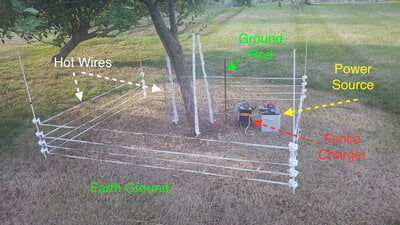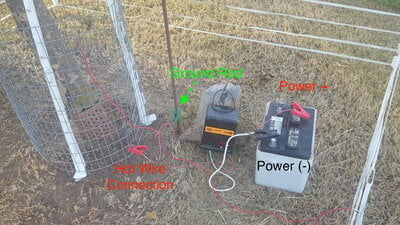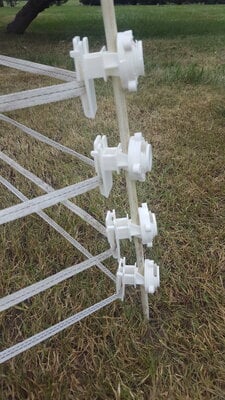For those considering the installation of an electric fence, or not sure of how they work, consider this to be a basic tutorial.


So all electric fence setups will be similar to this on, differing only in scale......meaning where you put your hot wires and how large of an area you encompass. But all consist of 4 basic components. 1. Fence Charger 2. power source 3. Ground Rod 4. Hot wire runs
The fence charger powers up or activates the hot wires.....generally with as large of 5,000 to as many as 15,000 volts. This is a high voltage, low amperage shock, which is both highly painful and relatively harmless, which makes it both safe and effective. The way the fencer works is about once every second, this high voltage pulse is sent down the hot wires. The fencer is also connected to the earth ground.....literally the soil you stand upon. So the two conductors are the hot wires and soil. So when an animal standing on the soil comes into contact with the hot wires, the juice flows through them to ground, which they feel as a violent, painful shock. Painful enough they will go into avoidance mode so it doesn't happen again. So the fence becomes a boundary they are reluctant to cross, so they leave it alone.
This is an enlarged layout of the fence charger hookup....
And lastly, the hot wires must be kept isolated.......meaning insulated......from the earth ground, so are supported by some type of insulators.

This one is new to me.....but consists of only a plain fiberglass rod, which is driven into the soil deep enough to support the fence (about 6 to 10 inches). Then two piece insulators are attached to it. With this setup, user is free to position the insulators where they want them......from nearly touching the deck to as far as needed. They can be placed as close as 2 inches apart.
This particular fence was built to prevent coons from raiding an apple tree. One day, tree had nearly 2 bushel of apples on it. Next morning.....top had been shredded and only a peck or two remained. Coons did that. Fence went up and as per game cameras, perimeter was probed all night, but the fence held. Traffic the next two nights has fallen off greatly.
Same could be done with a coop or run to keep varmints at arm's length......up to and including a larger area (yard), surrounding the coop or ranging area.


So all electric fence setups will be similar to this on, differing only in scale......meaning where you put your hot wires and how large of an area you encompass. But all consist of 4 basic components. 1. Fence Charger 2. power source 3. Ground Rod 4. Hot wire runs
The fence charger powers up or activates the hot wires.....generally with as large of 5,000 to as many as 15,000 volts. This is a high voltage, low amperage shock, which is both highly painful and relatively harmless, which makes it both safe and effective. The way the fencer works is about once every second, this high voltage pulse is sent down the hot wires. The fencer is also connected to the earth ground.....literally the soil you stand upon. So the two conductors are the hot wires and soil. So when an animal standing on the soil comes into contact with the hot wires, the juice flows through them to ground, which they feel as a violent, painful shock. Painful enough they will go into avoidance mode so it doesn't happen again. So the fence becomes a boundary they are reluctant to cross, so they leave it alone.
This is an enlarged layout of the fence charger hookup....

And lastly, the hot wires must be kept isolated.......meaning insulated......from the earth ground, so are supported by some type of insulators.

This one is new to me.....but consists of only a plain fiberglass rod, which is driven into the soil deep enough to support the fence (about 6 to 10 inches). Then two piece insulators are attached to it. With this setup, user is free to position the insulators where they want them......from nearly touching the deck to as far as needed. They can be placed as close as 2 inches apart.
This particular fence was built to prevent coons from raiding an apple tree. One day, tree had nearly 2 bushel of apples on it. Next morning.....top had been shredded and only a peck or two remained. Coons did that. Fence went up and as per game cameras, perimeter was probed all night, but the fence held. Traffic the next two nights has fallen off greatly.
Same could be done with a coop or run to keep varmints at arm's length......up to and including a larger area (yard), surrounding the coop or ranging area.
Last edited:


